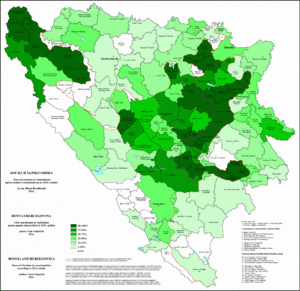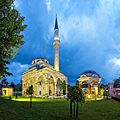Islam in Bosnia and Herzegovina facts for kids
Islam is the biggest religion in Bosnia and Herzegovina. It came to the country in the 1400s and 1500s. This happened when the Ottoman Empire took control of the area.
Today, about 51% of people in Bosnia and Herzegovina are Muslims. The other two large groups are Eastern Orthodox Christians (31%), who are mostly Serbs, and Roman Catholics (15%), who are mostly Croats.
Contents
Who are Bosnian Muslims?
Most Muslims in Bosnia and Herzegovina are called Bosniaks. Before 1993, people of Muslim culture were sometimes called "Muslimani." This was a way to describe their ethnic group. Some people also identified as Yugoslavs before the 1990s.
A small number of Muslims in Bosnia and Herzegovina are not Bosniaks. These include people from Albania, Roma communities, and Turkey.
Different Kinds of Islam
Most Muslims in Bosnia and Herzegovina follow Sunni Islam. This is the largest branch of Islam. They usually follow the Hanafi school of thought.
A survey in 2012 found that 54% of Muslims in Bosnia just called themselves "Muslims." About 38% said they were Sunni Muslims. There are also small groups of Sufi Muslims. You can find them mostly in Central Bosnia. A small Shia Muslim community also lives there.
Almost all Muslim groups in Bosnia and Herzegovina belong to one main organization. It is called the Islamic Community of Bosnia and Herzegovina. This group helps guide religious life.
Freedom to Practice Religion
The Constitution of Bosnia and Herzegovina protects everyone's right to practice their religion. This means people are free to follow their beliefs. This freedom is generally respected across the country.
Images for kids
-
Muslihudin Čekrekčija Mosque, Sarajevo, built in 1526
-
Karađoz Bey Mosque, Mostar, built in 1557
-
Ferhat Pasha Mosque in Banja Luka, built in 1579 (rebuilt in 2016)
-
Mosque, Mostar, built in 1617
-
Wooden mosque, Tuzla, from the 18th century
-
Ferhat Pasha Mosque in Banja Luka, built in 1579 (rebuilt in 2016)



















